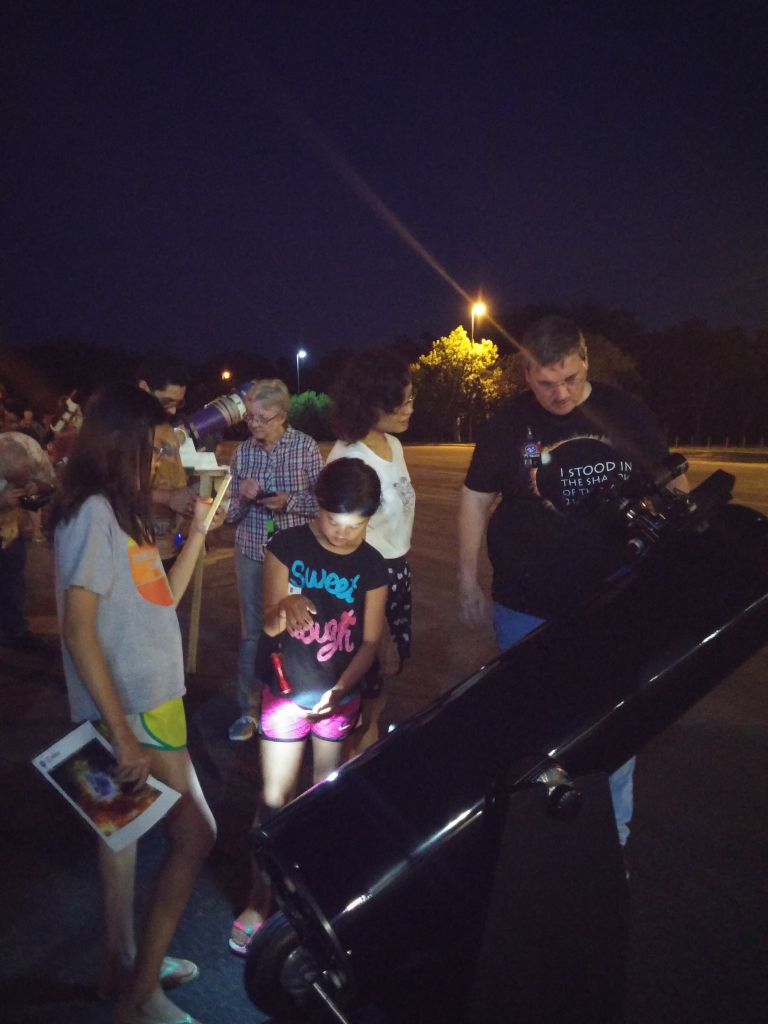
Saturday evening, the Brazos Valley Astronomy Club held what we called a Planetpalooza Star Party in the parking lot of the Brazos Center. Members set up their telescopes in the parking lot of the Brazos Center and showed off views of the Moon, Venus, Jupiter, Saturn and Mars to the public. My wife came along to help me out. I wanted to pass out NASA stickers to the kids but was worried I would be too busy operating the telescope and answering questions.
We met at the parking lot about an hour before the event in order to set up our equipment and eat a bite of pizza. I set up Zoomie (my 12" Dob) and got about half a slice of pizza in me when the first visitors arrived. I put down my pizza and headed towards the scope. The party had started!
As is quickly becoming my usual procedure at public outreach events, I attached my phone to the eyepiece, which allows a small group to view the image at the same time and prevents a lot of the accidental knocking about of my telescope and having to re-align after every person takes a peek. From my location, Venus was behind a tree, so I concentrated mainly on the Moon, Saturn and Jupiter. I knew the planets would require some magnification to see well, so I popped in my 2.5X barlow and 25mm eyepiece and stayed with that combination most of the night.
The sky wasn't even fully dark yet when the first visitors arrived, so I started with the obvious target: the Moon. It was just a few days past first quarter and the waxing gibbous phase was gorgeous. At my scope's magnification, only about half of it fit in the field. This wasn't ideal for showing off the moon's beauty in its entirety, but I hoped other members would be showing off that view. Instead, I used my camera app's zoom feature to drill down into surface details. While fiddling with the zoom, sometimes my finger would accidentally tap the shutter button and it would take a photo. Most of these weren't that great, but this one turned out nice.

While I had the telescope zoomed in on the Moon, I pointed out the Apollo 11 landing site to the visitors. One gentleman thanked me for showing the landing site, stating that he had always wondered where it was. He sounded almost in tears. I'll never know what special memory this held for him, but I felt honored to help him out.
After a bit, I changed targets to Jupiter. It was resting right above a Target parking lot full of outdoor lights, but it still managed to outshine the glare. All four Galilean moons were visible, although Callisto was in the widest part of its orbit and didn't always fit in the same field of view. On the planet itself, several cloud bands presented themselves and the Great Red Spot lived up to its reputation and was a nice crimson color that everyone could clearly see.
I pointed out that the GRS was a 400+ year old storm that was larger than two Earths put side to side and the entire planet was more than 10 Earth diameters across. This suitably impressed many of the visitors.

Next, I turned the telescope towards Saturn. Everyone was wowed by the rings, of course. One girl wanted to see what it looked like through my finder scope and was somewhat surprised that all she could see was a yellow star.
One of the disadvantages to showing objects at high power is that the objects slide out of view pretty rapidly. This allowed me to discuss Earth's rotation.
By this time, more people had arrived and I cycled back through the Moon, Jupiter and Saturn again. For those who stayed the entire evening, they found it interesting that the Great Red Spot on Jupiter had moved from being near the center of Jupiter to being a little towards one edge. I explained that the day on Jupiter was only 10 hours long, so even though it was 10 times as large as Earth, it rotated much more quickly.
After 10pm, Mars climbed above the trees. Tim moved his scope to a different part of the parking lot to get a better view for our audience. I looked at it a couple days ago at that altitude and the view wasn't that great, so I stuck with the other 3 objects for awhile.

Finally, around 10:30, it had climbed a little higher in the sky and I pointed towards the Red Planet. It was still a boiling orange-red blob in the eyepiece, but I could sometimes make out hints of its polar ice cap.
Most of the crowd had left by this time and the wind was picking up, making it difficult for me to keep my scope centered on the target. After the last person left, we began packing things up and heading home. The club members were commenting on how well the event went. My wife and I estimated that we had over 100 people come and look through the telescopes. I finally was able to down a complete slice of pizza and then went home - tired, but extremely satisfied.